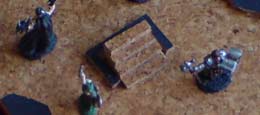Caverns pieces (figures & markers)
- Read about the Caverns board game.
See also:
cards | tiles | pieces | rules
You’ll need pieces to mark the position of the characters and monsters on the cavern tiles. Some cards also need markers. This is a list of the pieces you’ll need if you use all the example cards and tiles shown on these pages.
Players’ figures
- dwarf cleric (Fombin) 02601
- dwarf warrior (Golin) 02661?
- elf adventurer (Sorla) 03568 or 14553?
- elf wizard (Eldrin) 02552
- evil human cleric (Ulric) 02781
- half-orc fighter (Grug) 02669
- hobbit thief (Bimbim) 02769
- human cleric (Tolzar) 02681
- human enchantress (Esmerelda) 02682
- human hero (Sorquist) 02683
- human knight (Archibald) ?
- human paladin (Roderick) ?
The numbers are catalogue numbers from Reaper Miniatures on which some of the illustrations on the example set of cards were based (where I have managed to identify them... the rest are lost to the mists of time).
Tile markers
- stairs × 6 (representing steps up to the surface)
- spider web × 2
- the Holy Place
- the Magic Mirror
- the Wizard Door
- “Not Used” markers (several)
Monster figures
- bandit
- cave troll
- clay golem
- dark elf
- dragon
- gargoyle
- giant tunnel rat †
- goblin guard
- goblin
- hobgoblin guard
- Mim the dwarf †
- mummy
- orc soldier
- orc troublemaker
- skeleton
- snake × 2
- wraith
- zombie
Figures marked † are passage encounters rather than cavern-dwellers.
Also needed
- six-sided dice
Some notes
-
stairs
The stair markers serve to make it easier to see where the stairs are on the board. For example, the photo below shows stairs on the entrance tile.
-
webs
The spider web marker should cover the whole tile — for example, try using a square piece of transparent plastic with webs drawn on it.
License
This work is licensed under a
Creative Commons BY-NC license
(zip files containing all the card
illustrations and tiles are available for
download as a jumping-off point for you to create your own version). It
was inspired over twenty-five years ago by two original games — The
Sorcerer’s Cave and The Mystic Wood. Please read about the game’s origins to understand how
it came about.
